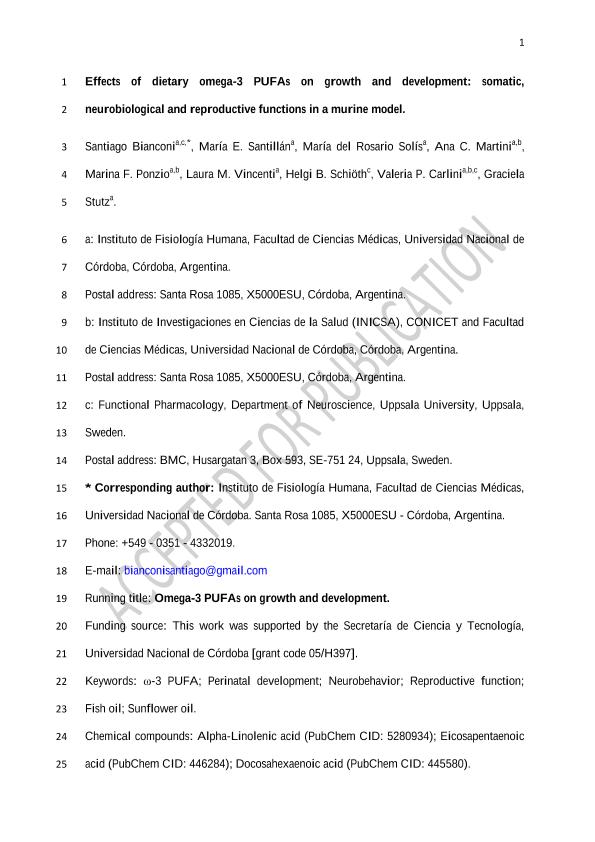Artículo
Effects of dietary omega-3 PUFAs on growth and development: Somatic, neurobiological and reproductive functions in a murine model
Bianconi, Santiago ; Santillan, Maria Emilia; Solís, María del Rosario; Martini, Ana Carolina
; Santillan, Maria Emilia; Solís, María del Rosario; Martini, Ana Carolina ; Ponzio, Marina Flavia
; Ponzio, Marina Flavia ; Vincenti, Laura María; Schiöth, Helgi B.; Carlini, Valeria Paola
; Vincenti, Laura María; Schiöth, Helgi B.; Carlini, Valeria Paola ; Stutz, Graciela
; Stutz, Graciela
 ; Santillan, Maria Emilia; Solís, María del Rosario; Martini, Ana Carolina
; Santillan, Maria Emilia; Solís, María del Rosario; Martini, Ana Carolina ; Ponzio, Marina Flavia
; Ponzio, Marina Flavia ; Vincenti, Laura María; Schiöth, Helgi B.; Carlini, Valeria Paola
; Vincenti, Laura María; Schiöth, Helgi B.; Carlini, Valeria Paola ; Stutz, Graciela
; Stutz, Graciela
Fecha de publicación:
11/2018
Editorial:
Elsevier Science Inc
Revista:
Journal Of Nutritional Biochemistry
ISSN:
0955-2863
Idioma:
Inglés
Tipo de recurso:
Artículo publicado
Clasificación temática:
Resumen
Omega-3 polyunsaturated fatty acids (ω-3 PUFAs) are relevant to fetal and infant growth and development. Objective: to assess whether long-term exposure to dietary ω-3 PUFA imbalance alters pre- and/or postnatal pups' development and reproductive function later in life. Mice dams were fed with ω-3 PUFA Control (soybean oil, 7%), Deficient (sunflower oil, 7%) or Excess (blend oil; 4.2% cod-liver+2.8% soybean) diet before conception and throughout gestation-lactation and later on, their pups received the same diet from weaning to adulthood. Offspring somatic, neurobiological and reproductive parameters were evaluated. Excess pups were lighter during the preweaning period and shorter in length from postnatal day (PND) 7 to 49, compared to Control pups (P<.05). On PND14, the percentage of pups with eye opening in Excess group was lower than those from Control and Deficient groups (P<.05). In Excess female offspring, puberty onset (vaginal opening and first estrus) occurred significantly later and the percentage of parthenogenetic oocytes on PND63 was higher than Control and Deficient ones (P<.05). Deficient pups were shorter in length (males: on PND14, 21, 35 and 49; females: on PND14, 21 and 42) compared with Control pups (P<.05). Deficient offspring exhibited higher percentage of bending spermatozoa compared to Control and Excess offspring (P<.05). These results show that either an excessively high or insufficient ω-3 PUFA consumption prior to conception until adulthood seems inadvisable because of the potential risks of short-term adverse effects on growth and development of the progeny or long-lasting effects on their reproductive maturation and function.
Archivos asociados
Licencia
Identificadores
Colecciones
Articulos(INICSA)
Articulos de INSTITUTO DE INVESTIGACIONES EN CIENCIAS DE LA SALUD
Articulos de INSTITUTO DE INVESTIGACIONES EN CIENCIAS DE LA SALUD
Citación
Bianconi, Santiago; Santillan, Maria Emilia; Solís, María del Rosario; Martini, Ana Carolina; Ponzio, Marina Flavia; et al.; Effects of dietary omega-3 PUFAs on growth and development: Somatic, neurobiological and reproductive functions in a murine model; Elsevier Science Inc; Journal Of Nutritional Biochemistry; 61; 11-2018; 82-90
Compartir
Altmétricas



